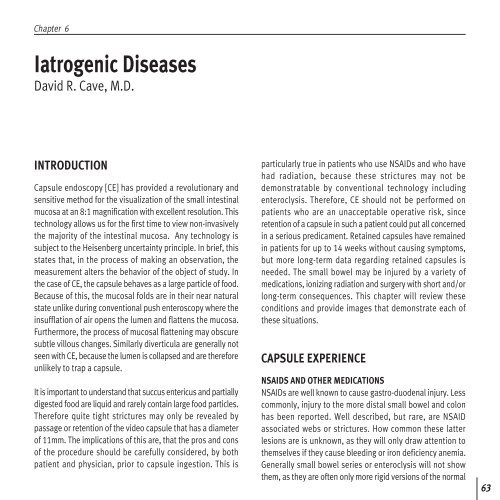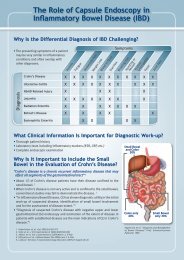capsule experience - MG Lorenzatto
capsule experience - MG Lorenzatto
capsule experience - MG Lorenzatto
You also want an ePaper? Increase the reach of your titles
YUMPU automatically turns print PDFs into web optimized ePapers that Google loves.
Chapter 6<br />
Iatrogenic Diseases<br />
David R. Cave, M.D.<br />
INTRODUCTION<br />
Capsule endoscopy [CE] has provided a revolutionary and<br />
sensitive method for the visualization of the small intestinal<br />
mucosa at an 8:1 magnification with excellent resolution. This<br />
technology allows us for the first time to view non-invasively<br />
the majority of the intestinal mucosa. Any technology is<br />
subject to the Heisenberg uncertainty principle. In brief, this<br />
states that, in the process of making an observation, the<br />
measurement alters the behavior of the object of study. In<br />
the case of CE, the <strong>capsule</strong> behaves as a large particle of food.<br />
Because of this, the mucosal folds are in their near natural<br />
state unlike during conventional push enteroscopy where the<br />
insufflation of air opens the lumen and flattens the mucosa.<br />
Furthermore, the process of mucosal flattening may obscure<br />
subtle villous changes. Similarly diverticula are generally not<br />
seen with CE, because the lumen is collapsed and are therefore<br />
unlikely to trap a <strong>capsule</strong>.<br />
It is important to understand that succus entericus and partially<br />
digested food are liquid and rarely contain large food particles.<br />
Therefore quite tight strictures may only be revealed by<br />
passage or retention of the video <strong>capsule</strong> that has a diameter<br />
of 11mm. The implications of this are, that the pros and cons<br />
of the procedure should be carefully considered, by both<br />
patient and physician, prior to <strong>capsule</strong> ingestion. This is<br />
particularly true in patients who use NSAIDs and who have<br />
had radiation, because these strictures may not be<br />
demonstratable by conventional technology including<br />
enteroclysis. Therefore, CE should not be performed on<br />
patients who are an unacceptable operative risk, since<br />
retention of a <strong>capsule</strong> in such a patient could put all concerned<br />
in a serious predicament. Retained <strong>capsule</strong>s have remained<br />
in patients for up to 14 weeks without causing symptoms,<br />
but more long-term data regarding retained <strong>capsule</strong>s is<br />
needed. The small bowel may be injured by a variety of<br />
medications, ionizing radiation and surgery with short and/or<br />
long-term consequences. This chapter will review these<br />
conditions and provide images that demonstrate each of<br />
these situations.<br />
CAPSULE EXPERIENCE<br />
NSAIDS AND OTHER MEDICATIONS<br />
NSAIDs are well known to cause gastro-duodenal injury. Less<br />
commonly, injury to the more distal small bowel and colon<br />
has been reported. Well described, but rare, are NSAID<br />
associated webs or strictures. How common these latter<br />
lesions are is unknown, as they will only draw attention to<br />
themselves if they cause bleeding or iron deficiency anemia.<br />
Generally small bowel series or enteroclysis will not show<br />
them, as they are often only more rigid versions of the normal<br />
63




